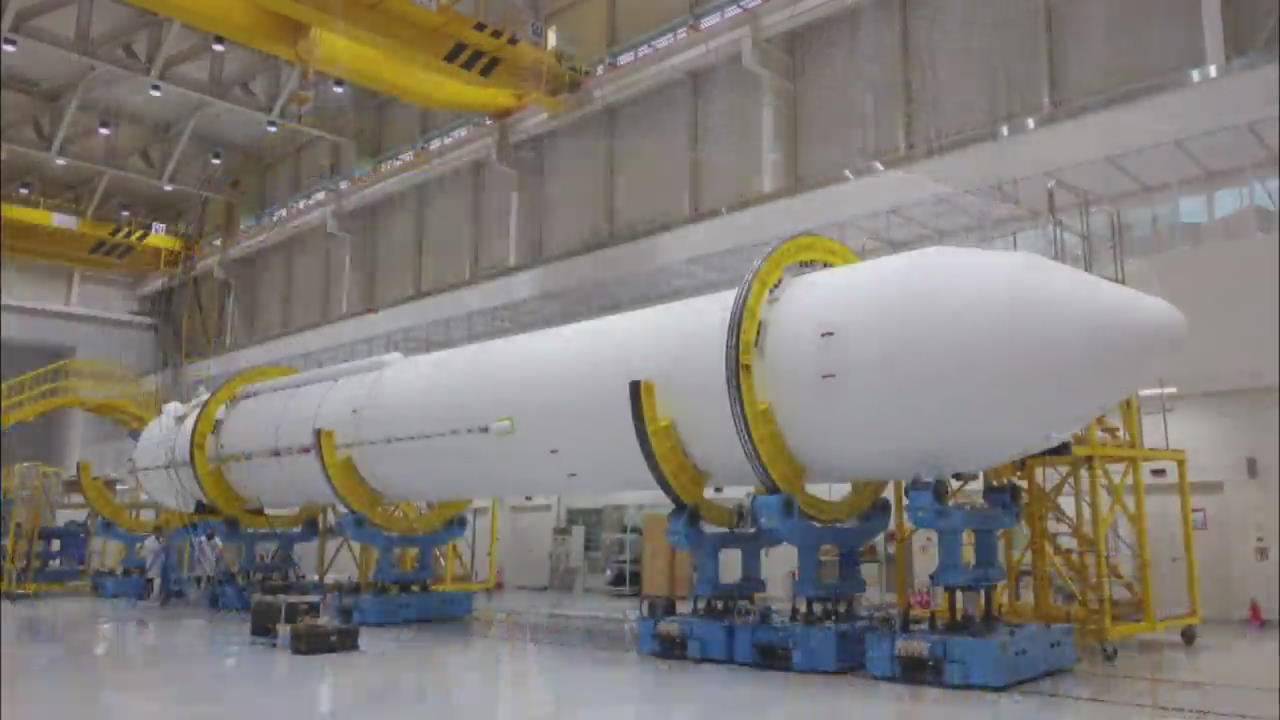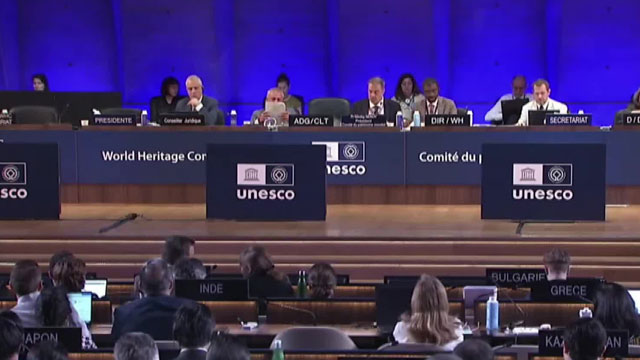Homegrown Rocket Tech
입력 2018.02.19 (15:10)
수정 2018.02.19 (16:41)
읽어주기 기능은 크롬기반의
브라우저에서만 사용하실 수 있습니다.
[Anchor Lead]
South Korea’s successful launch of the Naro rocket in 2013 was not entirely a homegrown achievement, as the Korean space program enlisted some help from Russia. A new rocket developed solely with local technology will be ready for a test launch in October. Here's an exclusive look at the rocket that is still getting some last-minute tune-ups.
[Pkg]
The rocket's lower part affixed with an engine is moved and assembled with the main body. Inside the rocket, engineers are busy wiring up the electronic devices. With the attachment of fairings on the nose cone, the entire rocket is revealed, measuring 2.6 meters in diameter and 26 meters in length. The completed rocket will undergo a combustion test in a vertical standing position before its maiden launch in October.
[Soundbite] Lee Chang-bae(Korea Aerospace Research Institute) : "It's a test of the engine's basic performance, but also a rehearsal for the Korean-made rocket."
If the test launch is successful, engineers will start clustering four 75-ton engines together. That would lead to the development of a Korean rocket with a first-stage thrust of 300 tons. It's expected to be smooth sailing from the point the 75-ton engine's performance is certified.
[Soundbite] Cho Ki-joo(Korea Aerospace Research Institute) : "I don't think it would be difficult once we test and check the compensation of interference and deviation errors that may occur from clustering four engines."
America's SpaceX program succeeded by using nine 80-ton engines together for the Falcon 9 rocket and as many as 27 engines for the Falcon Heavy recently. So, Korea's first test launch will be a crucial turning point for the nation's rocket development program. It's been five years since the successful launch of the Naro. The October launch of a test rocket made solely with home grown technology will help Korea continue its space programs and reach for the final frontier.
South Korea’s successful launch of the Naro rocket in 2013 was not entirely a homegrown achievement, as the Korean space program enlisted some help from Russia. A new rocket developed solely with local technology will be ready for a test launch in October. Here's an exclusive look at the rocket that is still getting some last-minute tune-ups.
[Pkg]
The rocket's lower part affixed with an engine is moved and assembled with the main body. Inside the rocket, engineers are busy wiring up the electronic devices. With the attachment of fairings on the nose cone, the entire rocket is revealed, measuring 2.6 meters in diameter and 26 meters in length. The completed rocket will undergo a combustion test in a vertical standing position before its maiden launch in October.
[Soundbite] Lee Chang-bae(Korea Aerospace Research Institute) : "It's a test of the engine's basic performance, but also a rehearsal for the Korean-made rocket."
If the test launch is successful, engineers will start clustering four 75-ton engines together. That would lead to the development of a Korean rocket with a first-stage thrust of 300 tons. It's expected to be smooth sailing from the point the 75-ton engine's performance is certified.
[Soundbite] Cho Ki-joo(Korea Aerospace Research Institute) : "I don't think it would be difficult once we test and check the compensation of interference and deviation errors that may occur from clustering four engines."
America's SpaceX program succeeded by using nine 80-ton engines together for the Falcon 9 rocket and as many as 27 engines for the Falcon Heavy recently. So, Korea's first test launch will be a crucial turning point for the nation's rocket development program. It's been five years since the successful launch of the Naro. The October launch of a test rocket made solely with home grown technology will help Korea continue its space programs and reach for the final frontier.
■ 제보하기
▷ 카카오톡 : 'KBS제보' 검색, 채널 추가
▷ 전화 : 02-781-1234, 4444
▷ 이메일 : kbs1234@kbs.co.kr
▷ 유튜브, 네이버, 카카오에서도 KBS뉴스를 구독해주세요!
- Homegrown Rocket Tech
-
- 입력 2018-02-19 15:02:07
- 수정2018-02-19 16:41:23

[Anchor Lead]
South Korea’s successful launch of the Naro rocket in 2013 was not entirely a homegrown achievement, as the Korean space program enlisted some help from Russia. A new rocket developed solely with local technology will be ready for a test launch in October. Here's an exclusive look at the rocket that is still getting some last-minute tune-ups.
[Pkg]
The rocket's lower part affixed with an engine is moved and assembled with the main body. Inside the rocket, engineers are busy wiring up the electronic devices. With the attachment of fairings on the nose cone, the entire rocket is revealed, measuring 2.6 meters in diameter and 26 meters in length. The completed rocket will undergo a combustion test in a vertical standing position before its maiden launch in October.
[Soundbite] Lee Chang-bae(Korea Aerospace Research Institute) : "It's a test of the engine's basic performance, but also a rehearsal for the Korean-made rocket."
If the test launch is successful, engineers will start clustering four 75-ton engines together. That would lead to the development of a Korean rocket with a first-stage thrust of 300 tons. It's expected to be smooth sailing from the point the 75-ton engine's performance is certified.
[Soundbite] Cho Ki-joo(Korea Aerospace Research Institute) : "I don't think it would be difficult once we test and check the compensation of interference and deviation errors that may occur from clustering four engines."
America's SpaceX program succeeded by using nine 80-ton engines together for the Falcon 9 rocket and as many as 27 engines for the Falcon Heavy recently. So, Korea's first test launch will be a crucial turning point for the nation's rocket development program. It's been five years since the successful launch of the Naro. The October launch of a test rocket made solely with home grown technology will help Korea continue its space programs and reach for the final frontier.
South Korea’s successful launch of the Naro rocket in 2013 was not entirely a homegrown achievement, as the Korean space program enlisted some help from Russia. A new rocket developed solely with local technology will be ready for a test launch in October. Here's an exclusive look at the rocket that is still getting some last-minute tune-ups.
[Pkg]
The rocket's lower part affixed with an engine is moved and assembled with the main body. Inside the rocket, engineers are busy wiring up the electronic devices. With the attachment of fairings on the nose cone, the entire rocket is revealed, measuring 2.6 meters in diameter and 26 meters in length. The completed rocket will undergo a combustion test in a vertical standing position before its maiden launch in October.
[Soundbite] Lee Chang-bae(Korea Aerospace Research Institute) : "It's a test of the engine's basic performance, but also a rehearsal for the Korean-made rocket."
If the test launch is successful, engineers will start clustering four 75-ton engines together. That would lead to the development of a Korean rocket with a first-stage thrust of 300 tons. It's expected to be smooth sailing from the point the 75-ton engine's performance is certified.
[Soundbite] Cho Ki-joo(Korea Aerospace Research Institute) : "I don't think it would be difficult once we test and check the compensation of interference and deviation errors that may occur from clustering four engines."
America's SpaceX program succeeded by using nine 80-ton engines together for the Falcon 9 rocket and as many as 27 engines for the Falcon Heavy recently. So, Korea's first test launch will be a crucial turning point for the nation's rocket development program. It's been five years since the successful launch of the Naro. The October launch of a test rocket made solely with home grown technology will help Korea continue its space programs and reach for the final frontier.
이 기사가 좋으셨다면
-
좋아요
0
-
응원해요
0
-
후속 원해요
0












![[속보] 순직 해병 특검 “오늘 오후 박정훈 대령 참고인 조사”](/data/layer/904/2025/07/20250716_MUM2IP.jpg)

![[단독] 김건희 특검, ‘공천 개입’ 관련 김영선 전 의원 소환 통보…일정 조율 중](/data/news/2025/07/16/20250716_p7hDHF.jpg)


이 기사에 대한 의견을 남겨주세요.